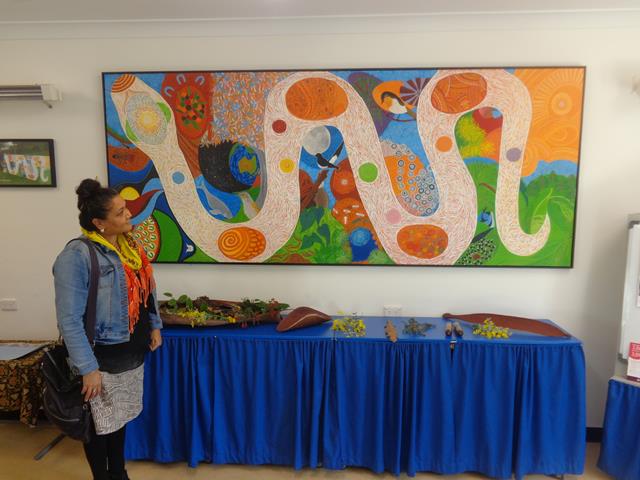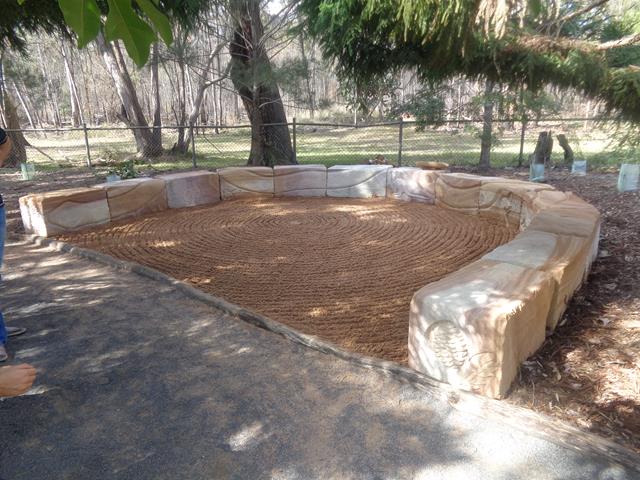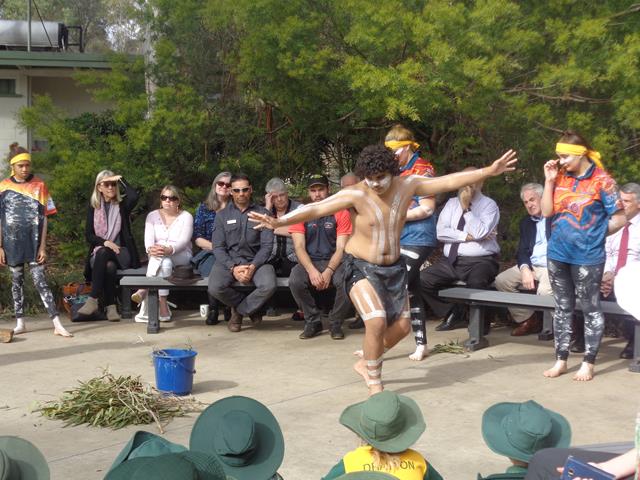Amaroo EEC sits on the unceded lands of the Jarowair people of the Western Wakka Wakka Nation. We pay our respects to their elders past, present and emerging and acknowledge their care for Country over millenia.
Indigenous Perspectives
The embedding of Indigenous perspectives is a key part of program design and delivery at Amaroo. A number of our programs are specifically aimed at teaching about First Nations culture.
First Nations Mural

Local Indigenous artist Kim Walmsley was commissioned by Amaroo to create a mural representing the journey through time and space as students come to the Centre for an experience through our programs on Indigenous perspectives and environmental sustainability.
Kim spent time considering the local flora and fauna around Amaroo as well as the creatures and themes of significance to the local Jarowair people. The mural she designed cleverly weaves these together. The dominant motif is that of Cabul the carpet python, with eggs representing the various stages of learning and growth as students return to Amaroo year after year for new experiences and insights into our environment and Aboriginal culture.
The tail of Cabul points to the distant Bunya Mountains, the destination for Indigenous people over thousands of years as they journeyed through the area around Amaroo to feast on Bunya nuts and participate in music and dance as well as arrange political affairs, settle disputes and organise marriages and initiations.
Yarning Circle
 Local stonemason Dan Gill was commissioned by Amaroo to create a unique sandstone border for our yarning circle.
Local stonemason Dan Gill was commissioned by Amaroo to create a unique sandstone border for our yarning circle.
A yarning circle is an area traditionally used by Murri people to discuss important issues and arrange their affairs. The presence of such a place at Amaroo is particularly significant as the Centre is on Jarowair land along the Bunya Highway, the path regularly trod by many thousands of Indigenous people over thousands of years to gather at the Bunya Mountains. Nearby there are male and female initiation sites which have been dated to at least 4000 years before present.
The yarning circle at Amaroo is a bed of sand bordered by carved sandstone blocks from the Helidon Hills. Stonemason Dan Gill crafted the blocks with their various motifs of local flora and fauna based on a mural painted for Amaroo by local Indigenous artist Kim Walmsley. The main motif is that of Cabul the carpet python, a significant totem or ‘yuri’ for the local Jarowair people and symbolic of the Rainbow Serpent.
The combination of aesthetics in the artistry, recognition of local Indigenous culture and history and embedding of the local environment in the blocks of the yarning circle makes for a compelling resource for both Amaroo and the Toowoomba/Highfields community. Over time the circle will be used by thousands of students, teachers and parents in a number of Amaroo programs concerned with environment and Indigenous perspectives.
Unveiling
 On July 21st 2016 the yarning circle at Amaroo Environmental Education Centre was unveiled before guests including local Aboriginal, Council and Education Department representatives. The ceremony began with a traditional welcome to country by local Jarowair man Conrad Bauwens and a smoking ceremony with dances led by Damon Anderson. Kim Walmsley, with the assistance of Indigenous Amaroo teacher Paul Carmody, set the scene with an explanation of her mural, then Dan Gill explained the process of creating the detailed sandstone blocks.
On July 21st 2016 the yarning circle at Amaroo Environmental Education Centre was unveiled before guests including local Aboriginal, Council and Education Department representatives. The ceremony began with a traditional welcome to country by local Jarowair man Conrad Bauwens and a smoking ceremony with dances led by Damon Anderson. Kim Walmsley, with the assistance of Indigenous Amaroo teacher Paul Carmody, set the scene with an explanation of her mural, then Dan Gill explained the process of creating the detailed sandstone blocks.